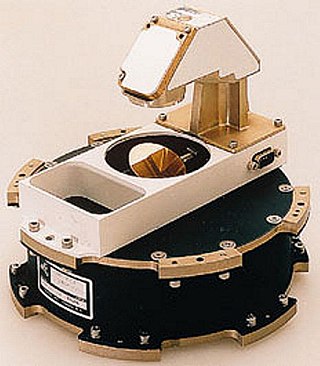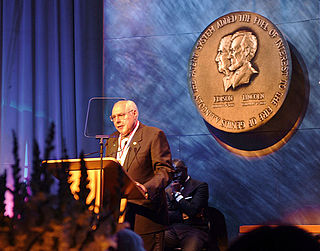
A space telescope or space observatory is a telescope in outer space used to observe astronomical objects. Suggested by Lyman Spitzer in 1946, the first operational telescopes were the American Orbiting Astronomical Observatory, OAO-2 launched in 1968, and the Soviet Orion 1 ultraviolet telescope aboard space station Salyut 1 in 1971. Space telescopes avoid several problems caused by the atmosphere, including the absorption or scattering of certain wavelengths of light, obstruction by clouds, and distortions due to atmospheric refraction such as twinkling. Space telescopes can also observe dim objects during the daytime, and they avoid light pollution which ground-based observatories encounter. They are divided into two types: Satellites which map the entire sky, and satellites which focus on selected astronomical objects or parts of the sky and beyond. Space telescopes are distinct from Earth imaging satellites, which point toward Earth for satellite imaging, applied for weather analysis, espionage, and other types of information gathering.

The Laboratory for Atmospheric and Space Physics (LASP) is a research organization at the University of Colorado Boulder. LASP is a research institute with over one hundred research scientists ranging in fields from solar influences, to Earth's and other planetary atmospherics processes, space weather, space plasma and dusty plasma physics. LASP has advanced technical capabilities specializing in designing, building, and operating spacecraft and spacecraft instruments.

A reaction wheel (RW) is used primarily by spacecraft for three-axis attitude control, and does not require rockets or external applicators of torque. They provide a high pointing accuracy, and are particularly useful when the spacecraft must be rotated by very small amounts, such as keeping a telescope pointed at a star.
Matra Marconi Space (MMS) was a Franco-British aerospace company.

The Space Telescope Science Institute (STScI) is the science operations center for the Hubble Space Telescope (HST), science operations and mission operations center for the James Webb Space Telescope (JWST), and science operations center for the Nancy Grace Roman Space Telescope. STScI was established in 1981 as a community-based science center that is operated for NASA by the Association of Universities for Research in Astronomy (AURA). STScI's offices are located on the Johns Hopkins University Homewood Campus and in the Rotunda building in Baltimore, Maryland.

The Spitzer Space Telescope, formerly the Space Infrared Telescope Facility (SIRTF), is an infrared space telescope launched in 2003, that was deactivated when operations ended on 30 January 2020. Spitzer was the third space telescope dedicated to infrared astronomy, following IRAS (1983) and ISO (1995–1998). It was the first spacecraft to use an Earth-trailing orbit, later used by the Kepler planet-finder.

The Goddard Space Flight Center (GSFC) is a major NASA space research laboratory located approximately 6.5 miles (10.5 km) northeast of Washington, D.C. in Greenbelt, Maryland, United States. Established on May 1, 1959 as NASA's first space flight center, GSFC employs about 10,000 civil servants and contractors. Named for American rocket propulsion pioneer Robert H. Goddard, it is one of ten major NASA field centers. GSFC is partially within the former Goddard census-designated place; it has a Greenbelt mailing address.
The RAD750 is a radiation-hardened single-board computer manufactured by BAE Systems Electronics, Intelligence & Support. The successor of the RAD6000, the RAD750 is for use in high-radiation environments experienced on board satellites and spacecraft. The RAD750 was released in 2001, with the first units launched into space in 2005.
Collins Aerospace is an American technology company that is one of the world's largest suppliers of aerospace and defense products. Headquartered in Charlotte, North Carolina, it is a subsidiary of RTX Corporation.

The China Aerospace Science and Technology Corporation (CASC) is a main contractor for the Chinese space program. It is state-owned and has subsidiaries which design, develop and manufacture a range of spacecraft, launch vehicles, and ground equipment. It also has a division for strategic and tactical missile systems.

Submillimeter Wave Astronomy Satellite is a NASA submillimetre astronomy satellite, and is the fourth spacecraft in the Small Explorer program (SMEX). It was launched on 6 December 1998, at 00:57:54 UTC, from Vandenberg Air Force Base aboard a Pegasus XL launch vehicle. The telescope was designed by the Smithsonian Astrophysical Observatory (SAO) and integrated by Ball Aerospace, while the spacecraft was built by NASA's Goddard Space Flight Center (GSFC). The mission's principal investigator is Gary J. Melnick.

Frank J. "Cepi" Cepollina is an American engineer and inventor. He was officially inducted to the National Inventors Hall of Fame for his pioneering concept of in-orbit satellite servicing in May 2003. His organizational leadership style has been compared to that of Al Davis of the National Football League's Oakland Raiders.

The National Aeronautics and Space Administration is an independent agency of the U.S. federal government responsible for the civil space program, aeronautics research, and space research. Established in 1958, it succeeded the National Advisory Committee for Aeronautics (NACA) to give the U.S. space development effort a distinctly civilian orientation, emphasizing peaceful applications in space science. It has since led most American space exploration, including Project Mercury, Project Gemini, the 1968–1972 Apollo Moon landing missions, the Skylab space station, and the Space Shuttle. It currently supports the International Space Station and oversees the development of the Orion spacecraft and the Space Launch System for the crewed lunar Artemis program, the Commercial Crew spacecraft, and the planned Lunar Gateway space station.
The Space Based Space Surveillance (SBSS) system is a planned United States Space Force constellation of satellites and supporting ground infrastructure that will improve the ability of the United States Department of Defense (DoD) to detect and track space objects in orbit around the Earth.

Space research is scientific study carried out in outer space, and by studying outer space. From the use of space technology to the observable universe, space research is a wide research field. Earth science, materials science, biology, medicine, and physics all apply to the space research environment. The term includes scientific payloads at any altitude from deep space to low Earth orbit, extended to include sounding rocket research in the upper atmosphere, and high-altitude balloons.
Airbus Defence and Space is the division of Airbus SE responsible for the development and manufacturing of the corporation's defence and space products and providing related services. The division was formed in January 2014 during the corporate restructuring of European Aeronautic Defence and Space (EADS) into Airbus SE, and comprises the former Airbus Military, Astrium, and Cassidian divisions. It is said to be the second largest space company in the world.

Fine Guidance Sensor (FGS) for the Hubble Space Telescope is a system of three instruments used for pointing the telescope in space, and also for astrometry and its related sciences. To enable aiming the telescope at a specific spot in the sky, each FGS combines optics and electronics. There are three Hubble FGS, and they have been upgraded over the lifetime of the telescope by crewed Space Shuttle missions. The instruments can support pointing of 2 milli-arc seconds. The three FGS are part of the Hubble Space Telescope's Pointing Control System, aka PCS. The FGS function in combination with the Hubble main computer and gyroscopes, with the FGS providing data to the computer as sensors which enables the HST to track astronomical targets.
MethaneSAT is an American-New Zealand space mission launched in 2024 aboard SpaceX's Transporter 10 rideshare mission. It is an Earth observation satellite that will monitor and study global methane emissions in order to combat climate change. The spacecraft will carry a high performance spectrometer methane sensing system, which will allow the spacecraft to take high resolution measurements of global methane emissions from roughly 50 major regions across Earth.












